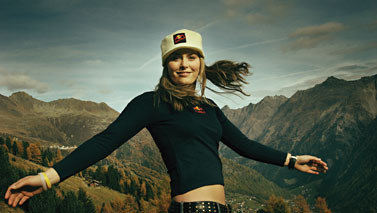Lindsey Kildow isn’t used to taking anything slow: The 23-year-old Olympic skier got her start on the slopes before she was 3 years old and fell in love with the snow immediately. By age 6, she was competing in her first ski races.
Before long, the Burnsville, Minn., native was commuting between Minnesota and Colorado to train and compete, and her father, a Minneapolis attorney whose own promising skiing career was cut short by a knee injury, realized it was time to relocate. So when Kildow was 12, her parents (her mother is also an attorney) and four younger siblings headed to Vail, Colo., so she could pursue her skiing dreams.
The move paid off.
In 1999, at age 14, Kildow became the first U.S. woman to win Italy’s Trofeo Topolino contest (a.k.a. the junior junior World Cup). She went on to win gold in the downhill event at the 2004 World Cup in Lake Louise, Canada, before setting her sights on the 2006 Olympics in Torino, where she hoped to take the podium in one of her five races (downhill, slalom, giant slalom, combined slalom and super-giant slalom).
But on Feb. 13, 2006, Kildow fell — hard — on a downhill training run in Torino. “It was really weird. I was just skiing along, and my ski caught, and I didn’t even feel it at first,” she says. “I was doing the splits, going like 50 miles an hour, and then I went over the jump.”
Kildow flew 15 feet in the air and landed on her back. “I initially thought my back was broken,” she says. “It was the most intense pain I’ve ever felt. I was freaking out, and they had to airlift me to the hospital.”
Miraculously, Kildow walked away with relatively minor injuries, including a bruised hip, and returned 24 hours later to finish eighth in the downhill race. She continued in the competition, but the spill took its toll on her performance. She competed in four of her five races, but wasn’t able to break into the top three.
“The Olympics are so challenging, and they’re only every four years, so I didn’t want to let that opportunity pass,” she says. “If I had taken time off right away, I probably would have healed faster, but it’s in my nature to never stop.”
After a period of intense training focused on improving her core strength, Kildow started the 2006–07 season strong. She earned two silver medals in the downhill and super-giant slalom at the World Alpine Skiing Championships in Are, Sweden. But then she took a fall on the slalom-training course and partially tore the anterior cruciate ligament (ACL) in her right knee. Once again, she faced her own resistance to giving up on the rest of the season.
“The last thing I wanted to do was to stop,” she says. But doctors warned her that continuing to race with a partial tear would likely lead to a complete tear — and a much longer recovery time. So Kildow made the decision to call it quits for the remainder of the season. “I want to ski for a long time to come, for at least the next eight to 10 years,” she says. “I thought it was smarter to take time off now. I had to look to the future.”
The injury kept Kildow off the slopes for about five months as she rebuilt her lower-body strength — a process that left her feeling restless. But she kept telling herself, “If I work hard now, it’ll pay off later.” To keep her spirits up, Kildow took up golf to get outdoors and spent time with friends, including her future husband, former U.S. Olympic skier Thomas Vonn.
The payoff came in more ways than she might have imagined. In August, Kildow was able to join the U.S. Olympic ski team for their training camp in New Zealand. And in September, she and Vonn married. “I’m building up great momentum and I’m really positive,” she says. “I think I’m racing better this year than I was last year, even with the injuries.”
A good thing, since Kildow has lofty goals. She’s already looking ahead to the 2010 Olympics in Vancouver and hopes to compete in three or four more Olympics in her lifetime. She also dreams of winning the overall title in the World Cup, one of downhill skiing’s most prestigious honors.
But what keeps Kildow going isn’t the podium-finish or the prospect of gold — it’s the pure joy of skiing. “When it’s a sunny day and the snow is perfect and you make a really nice turn — it’s just a really cool feeling,” she says. “I have fun every time I go skiing. No matter what, I never get sick of it.”

This Post Has 0 Comments